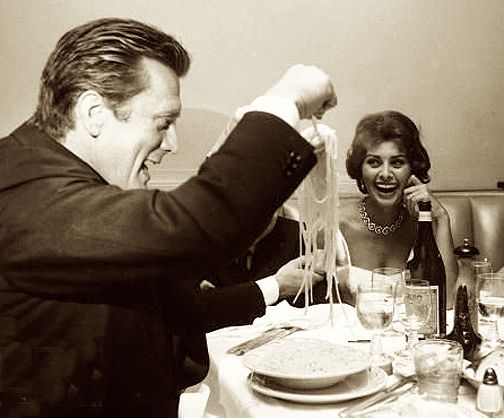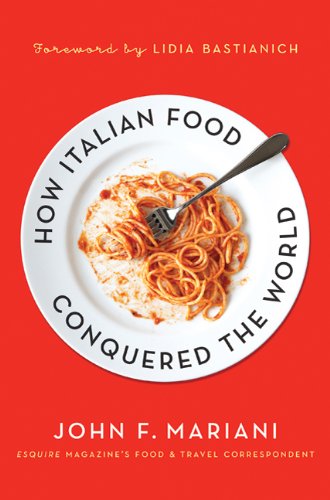MARIANI’S
Virtual
Gourmet
July
18, 2021
NEWSLETTER
❖❖❖
IN THIS ISSUE
ESCAPE TO THE ISLAND OF FAVIGNANA
By John Mariani
NEW YORK CORNER
TASCA
By John Mariani
CAPONE'S GOLD
CHAPTER 16
By John Mariani
NOTES FROM THE WINE CELLAR
THE LAST ROSES OF SUMMER
By John Mariani
❖❖❖
 On this week's episode of my WVOX
Radio Show "Almost Golden"
On this week's episode of my WVOX
Radio Show "Almost Golden"  for JULY 21 at 11AM
EST,I will be interviewing LARRY TYE, Author of Demagogue:
The Life and Long Shadow of Senator Joe
McCarthy. Go to: WVOX.com.
The episode will also be archived at: almostgolden.
for JULY 21 at 11AM
EST,I will be interviewing LARRY TYE, Author of Demagogue:
The Life and Long Shadow of Senator Joe
McCarthy. Go to: WVOX.com.
The episode will also be archived at: almostgolden.❖❖❖
ESCAPE TO THE ISLAND OF FAVIGNANA
By John Mariani
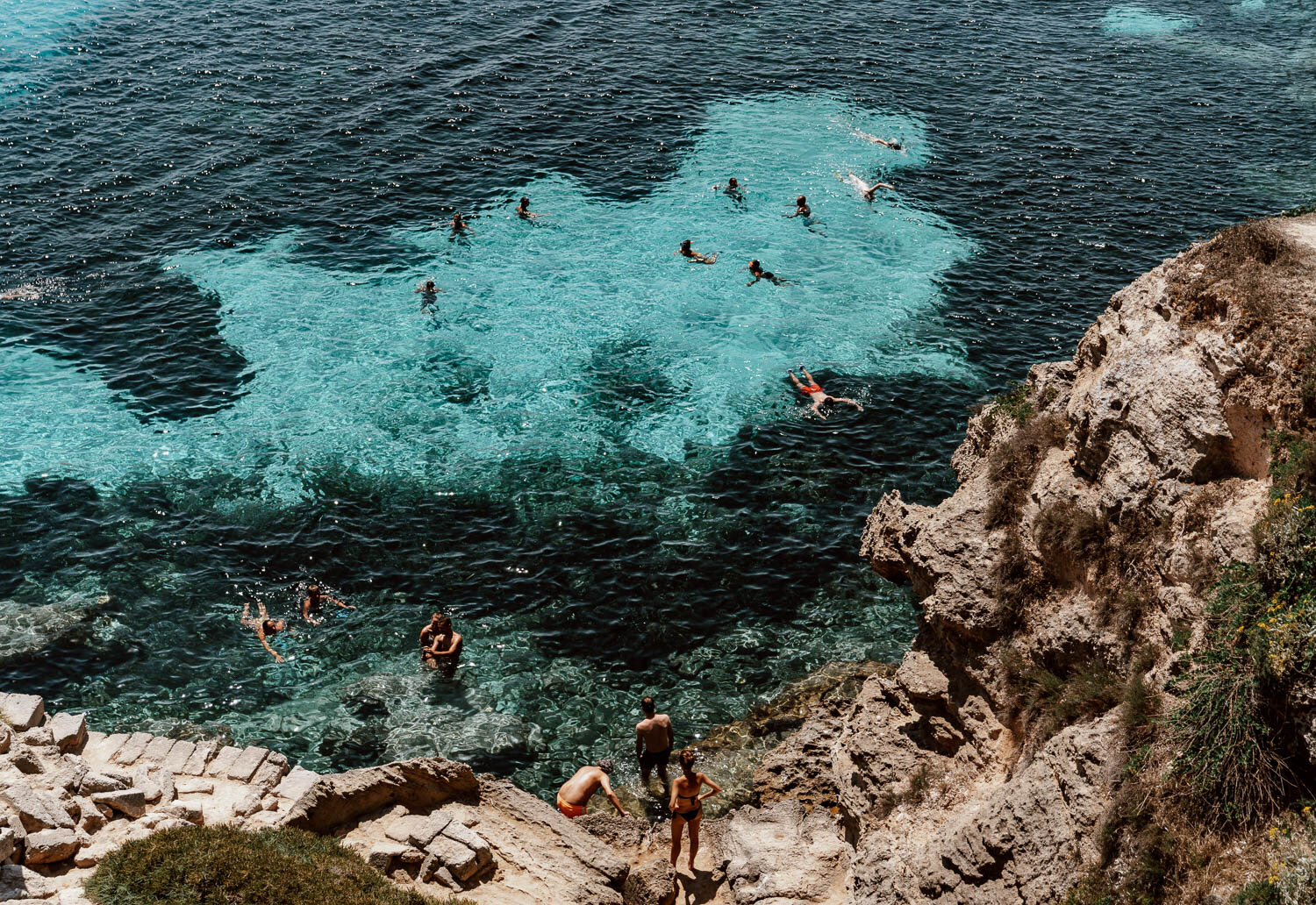
Bue Marino on Favignana
Italy’s southern island
of Sicily is a huge 10-million-square-mile chunk
of volcanic land in the Mediterranean with a
population of five million. But off its
northwestern coast are three small Aegadian
islands, 175 miles from Tunis, of which the
largest, Favignana, is less than three miles at
its widest point, with a population of just over
4,000 people. The only way to get there is by
boat, 11 miles 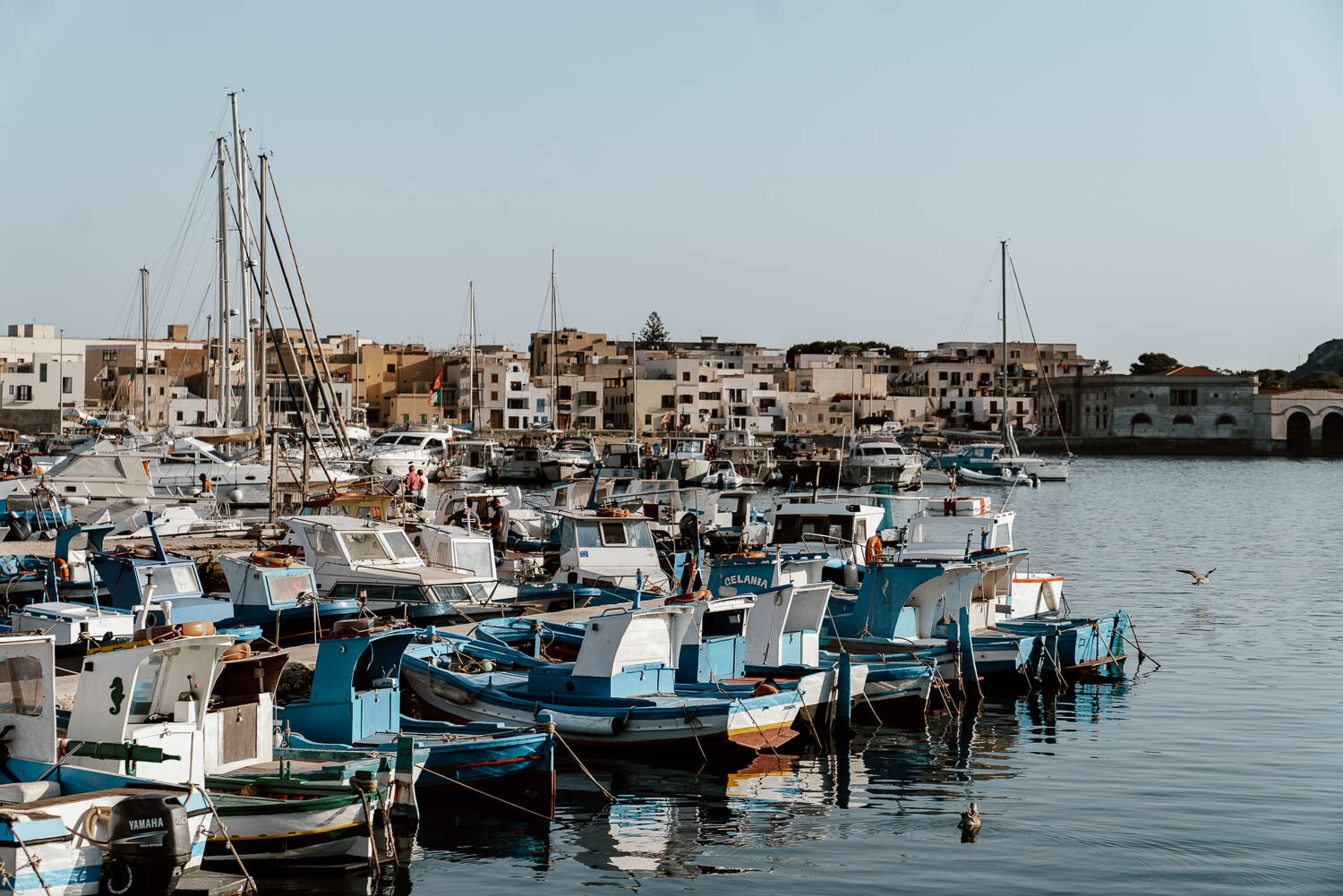 from
the Sicilian town of Trapani, so, although it
gets tourists during the season, it is still a
largely unfamiliar, craggy, cave-pocked and
reclusive place, where peace and quiet is the
rule and the beaches are relatively barren.
from
the Sicilian town of Trapani, so, although it
gets tourists during the season, it is still a
largely unfamiliar, craggy, cave-pocked and
reclusive place, where peace and quiet is the
rule and the beaches are relatively barren.
Four strong winds blow through
Favignana—the Mistral from the northwest, the
Sirocco from the southeast, the Greco from the
northeast and the Libyan from the southwest—whose
name comes from a fishing net called the levanzo.
It is not home to chain hotels or golf
courses, and the colorful wooden boats in the
harbor are owned by fishermen for whom the tuna
industry is a sustaining tonnara
tradition that awaits the bluefins’ arrival and
their mass capture called the mattanza that
occurs May through June. The canning industry was
created there by Vincenzo Florio, better known as
the Marsala wine producer, and built up at a
factory on the island by Ignazio Florio, at one
time employing 800 men and women, while the
island’s nuns tended their children.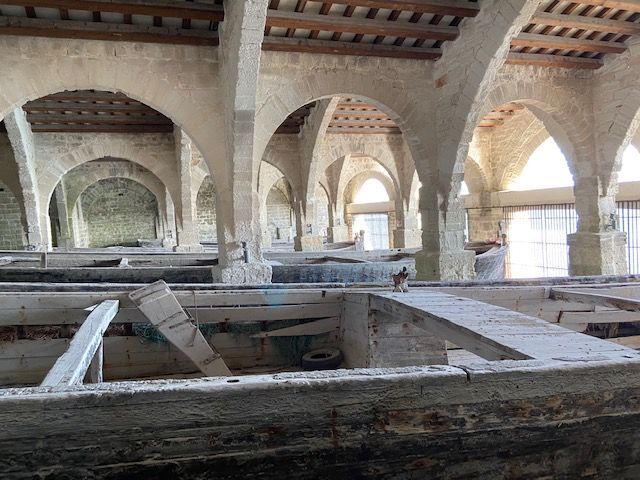
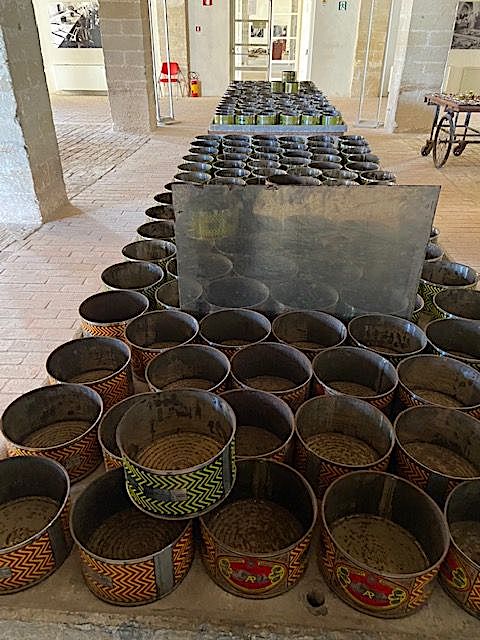 Today
the processing and canning occurs in nearby
Trapani, and tuna yields are not what they once
were. You can still visit the vast pink
sand-colored processing plant (left and right)
with its fine lancet archways and towers, where
enormous amounts of fish were prepared for
canning, and if you’re lucky, you may find an
old-timer still singing the old dialect tributes
to the tuna while they were being fished.
Today
the processing and canning occurs in nearby
Trapani, and tuna yields are not what they once
were. You can still visit the vast pink
sand-colored processing plant (left and right)
with its fine lancet archways and towers, where
enormous amounts of fish were prepared for
canning, and if you’re lucky, you may find an
old-timer still singing the old dialect tributes
to the tuna while they were being fished.
During World War II,
as the story goes, Gen. Patton’s invasion of
Sicily caused him to send two officers on an
expedition to each of the Aegadian islands in a
fishing boat they bought for three dollars. Once
they were onshore Favignana the Italian Lt.
Colonel there was only too happy to surrender the
islands to the Americans.
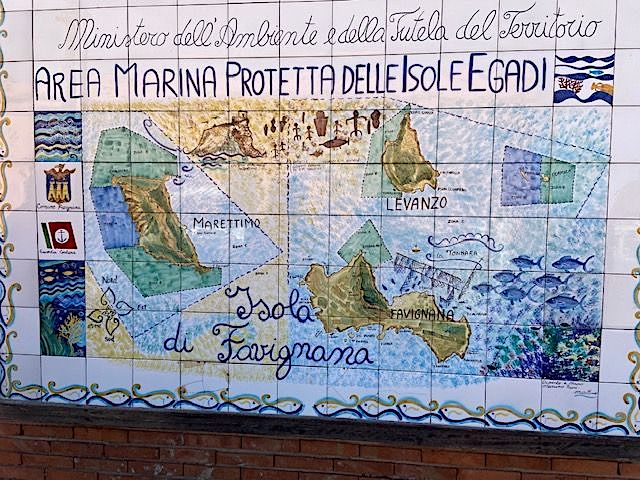 To
get to Favignana you take the Liberty Lines
hydrofoil ferry out of Trapani, a half-hour trip
(about $25 round-trip). You slow down and glide
into the boat-packed harbor, and when you
disembark head for the café right there on the
docks and order their specialty, a delicious
espresso with pistachio cream (which you can
purchase there or at any good Italian grocery). Since no
one brings a car to the island, you can walk
around the town in a leisurely morning or rent a
bike at the docks—there’s a big green sign reading
“RENT”—for about $12 a day, or find older bikes
for half that price.
To
get to Favignana you take the Liberty Lines
hydrofoil ferry out of Trapani, a half-hour trip
(about $25 round-trip). You slow down and glide
into the boat-packed harbor, and when you
disembark head for the café right there on the
docks and order their specialty, a delicious
espresso with pistachio cream (which you can
purchase there or at any good Italian grocery). Since no
one brings a car to the island, you can walk
around the town in a leisurely morning or rent a
bike at the docks—there’s a big green sign reading
“RENT”—for about $12 a day, or find older bikes
for half that price.
Bikes will be necessary to visit one of
Favignana’s several beaches, including Cala Rossa,
perhaps the most crowded, and Bue Marino, among
the rocks and caves with a food truck selling tuna
sandwiches. You can also hire boat guides to sail
you around the island. 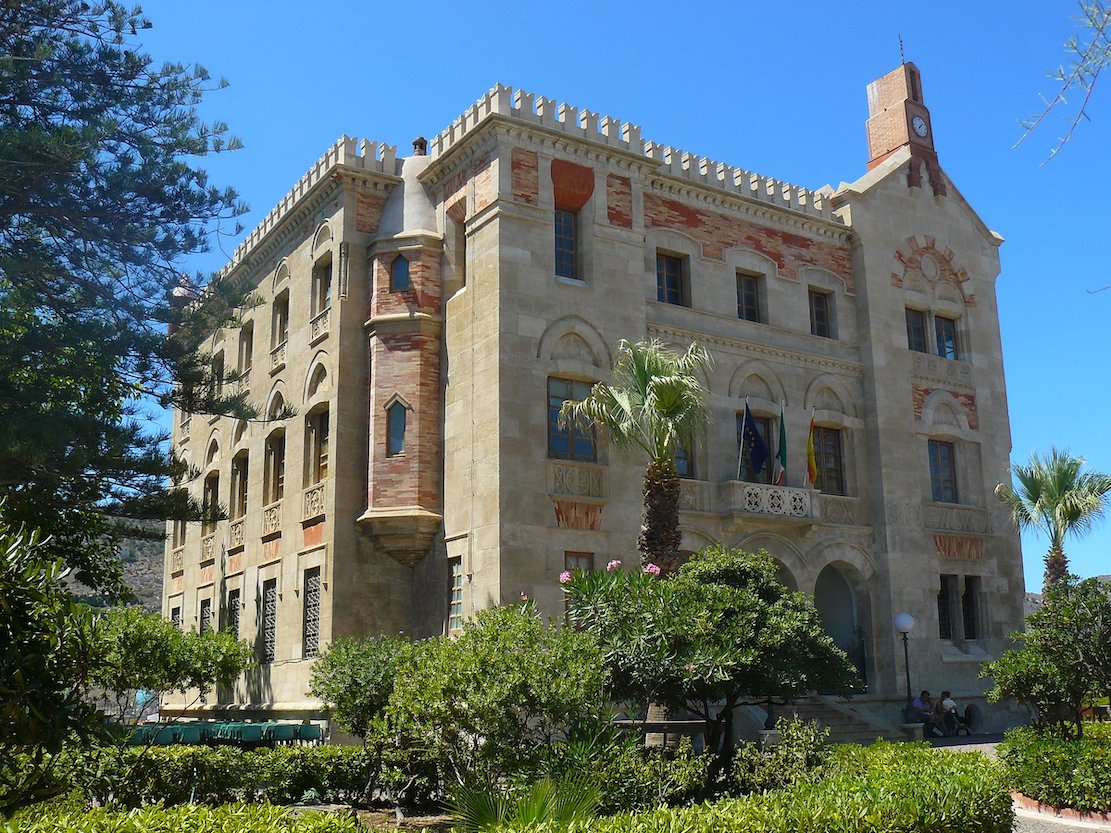 The
beaches, despite all the rocky surroundings, can
have more fine sand than many stony strands in the
Mediterranean and the views of the mountains and
other islands are wonderfully calming.
The
beaches, despite all the rocky surroundings, can
have more fine sand than many stony strands in the
Mediterranean and the views of the mountains and
other islands are wonderfully calming.
Downtown, if you wish to call something so
small and compact a downtown, has the sun-bleached
buildings of the southern Mediterranean and the
usual oversupply of churches, along with the 19th
century Villa Florio (right), now
a museum of local history. The island offers a
slew of B&Bs, many on or near the beach, like
La Praya 5, currently renting for
$166 per night, with breakfast. The new Cave
Garden Rooms (right) are
set dramatically right over the caves, for $178.
 Brand new is stylishly
appointed Calamoni
di Favignana apartments,
beautifully laid out right next to the Firriato
family vineyards and a short walk to the lapping
sea. With one- and two-bedroom apartments and
villas, prices start around $1,000 a night.
Brand new is stylishly
appointed Calamoni
di Favignana apartments,
beautifully laid out right next to the Firriato
family vineyards and a short walk to the lapping
sea. With one- and two-bedroom apartments and
villas, prices start around $1,000 a night.
There are plenty of good, causal trattorias
on the island, all with seafood-based menus. The
extremely popular, quaintly named Quello Che
C’e C’e (left) on the Via Garibaldi,
which roughly translates to “It is what it is,” is
always packed during the season, and the outdoor
tables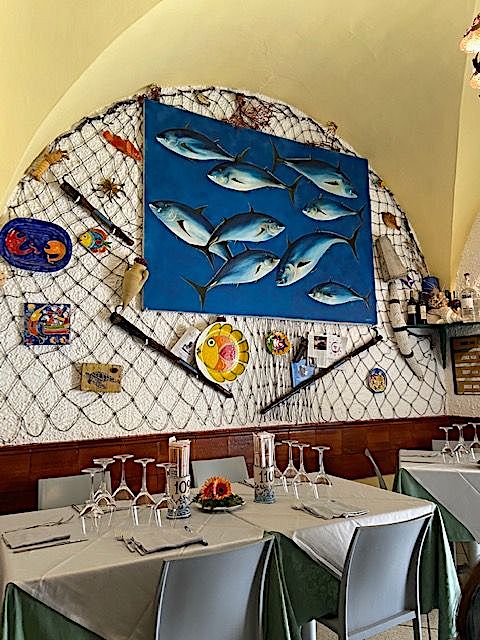 are sought out and occupied early, but meals move
fast. Pastas run about $15, main courses around
$25. The focaccia is irresistible.
are sought out and occupied early, but meals move
fast. Pastas run about $15, main courses around
$25. The focaccia is irresistible.
I
had a splendid, very convivial meal at the family
owned Trattoria
del Pescador (right), the town’s
oldest, since 1974, set on the
Piazza Europa. It’s rustic and folkloric and very
pretty, and you will be greeted by the owner Rino,
who will bring out a platter with a variety of the
day’s catch, which will then be prepared by his
wife Rosa. In every bite of her food there is the
briny taste of the Mediterranean. The food is not
fussy but simply lustrous and the dishes abundant
and meant to be shared.
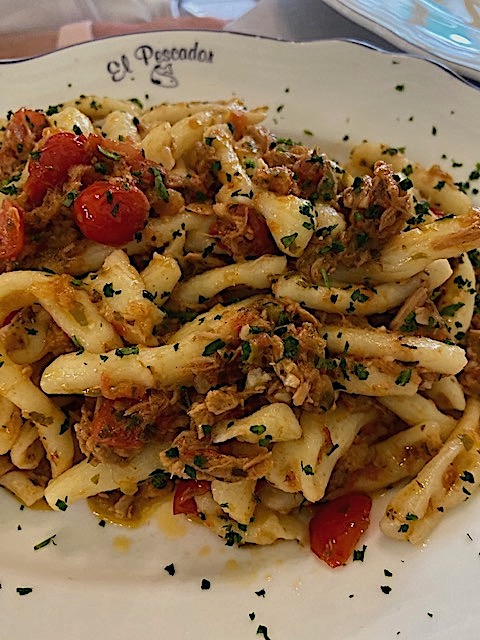 We started with some antipasti, then a
pasta with mildly flavorful bottarga
roe and another with small, tender clams in the
shell. There was also freshly made busiate noodles,
whose hole in the middle of the long strands is
made with a knitting needle. A lustrous sarago
(bream) was dressed in a salmoriglio
sauce of oil, pepper and lemon, and preo (dentice)
was
simply grilled and meaty. Pasta run $14-$27; main
courses $17-$33, with some fish sold by the grams.
We started with some antipasti, then a
pasta with mildly flavorful bottarga
roe and another with small, tender clams in the
shell. There was also freshly made busiate noodles,
whose hole in the middle of the long strands is
made with a knitting needle. A lustrous sarago
(bream) was dressed in a salmoriglio
sauce of oil, pepper and lemon, and preo (dentice)
was
simply grilled and meaty. Pasta run $14-$27; main
courses $17-$33, with some fish sold by the grams.
With the meal we drank a Firriato Favinia
2012 made from Nero d’Avola grapes and after
dinner a raisin-like Passitio 2015 from the same
producer. You
can skip the cloyingly sweet cassata cake for
dessert.
At late afternoon we were back
on the ferry, cutting through choppy water, and as
Favignana receded in the distance, it seemed to
return to the sea like a sprite awaiting the
sunset.
TASCA
505 Columbus Avenue
212-362-221
By John Mariani

The Upper West Side,
which the New York food media almost completely
ignores, has long been fertile ground for
storefront restaurants of every stripe, block by
block, sometimes two or three on each block.
Tasca, which occupies a two-level,
5,500-square-foot space, is an exciting new
addition near the Museum of Natural History. It is
highly innovative in that the menu has combined
the flavors of Iberia—tasca
means tavern—not just Spain and Portugal but also
the Latin countries of the Caribbean: Puerto Rico,
the Dominican Republic and Cuba. And it’s all done
with admirable color and dash.
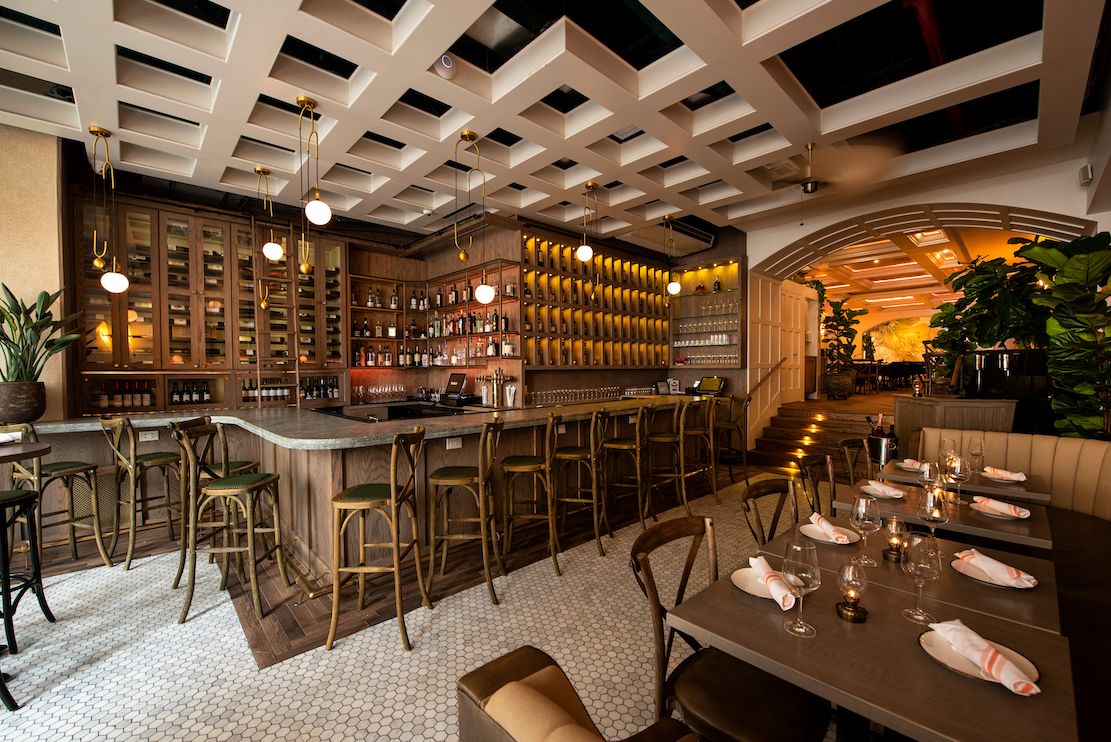 In
fact, I’ve found the seasoning and spicing at
Tasca wonderfully elevated from the way I’ve
experienced much of the cooking of Latin
countries, where the array of spices varies
greatly. In Spain, garlic is used sparingly—the
exceptions are garlic soup, shrimp or angulas à la
bilbaina, eels served in bubbling garlic
oil—and hot chili peppers are rare. Indeed, in
Penelope Casas’s excellent Delicioso!
The Regional Cooking of Spain (1996) chilies
are not mentioned at all; neither are they in Memories of a
Cuban Kitchen (1992) by Mary Urrutia
Randelman and Joan Schwartz. And a recipe for the
classic Dominican Republic dish called pollo
guisado,in the on-line Dominican
Cooking,
In
fact, I’ve found the seasoning and spicing at
Tasca wonderfully elevated from the way I’ve
experienced much of the cooking of Latin
countries, where the array of spices varies
greatly. In Spain, garlic is used sparingly—the
exceptions are garlic soup, shrimp or angulas à la
bilbaina, eels served in bubbling garlic
oil—and hot chili peppers are rare. Indeed, in
Penelope Casas’s excellent Delicioso!
The Regional Cooking of Spain (1996) chilies
are not mentioned at all; neither are they in Memories of a
Cuban Kitchen (1992) by Mary Urrutia
Randelman and Joan Schwartz. And a recipe for the
classic Dominican Republic dish called pollo
guisado,in the on-line Dominican
Cooking, contains only a half-teaspoon of garlic and the
festive dish sancocho
but one teaspoon.
At Tasca, a wide range of ingredients are
used to heighten and brighten every dish while
respecting the fundamentals of the food culture
that produced it.
contains only a half-teaspoon of garlic and the
festive dish sancocho
but one teaspoon.
At Tasca, a wide range of ingredients are
used to heighten and brighten every dish while
respecting the fundamentals of the food culture
that produced it.
Tasca’s owners, Jay, Norisa and their son
Justin Espinal, took over the all-white-and-blue
premises of a Greek restaurant named Kefi, and
turned it to look more like a Spanish tavern, with
a wine cellar downstairs. The arched passage from
the bar to the main dining room is complemented by
a striking latticework on high ceilings, with a
lovely mural of Caribbean flora and fauna.
Lighting is good and the noise level not bad,
depending on the vocal power of the people at
other tables.
Consulting chef René Hernandez trained at
El Bulli with Ferran Adrià, with Tasca’s head
chef, Rufino Peralta, exhibiting the
less-extravagant side of modernism, as seen in the
dozen or so tapas,
including vieras
(diver’s scallops) crusted with cassava and served
with a green fava bean compote ($17); a special of
scallops over 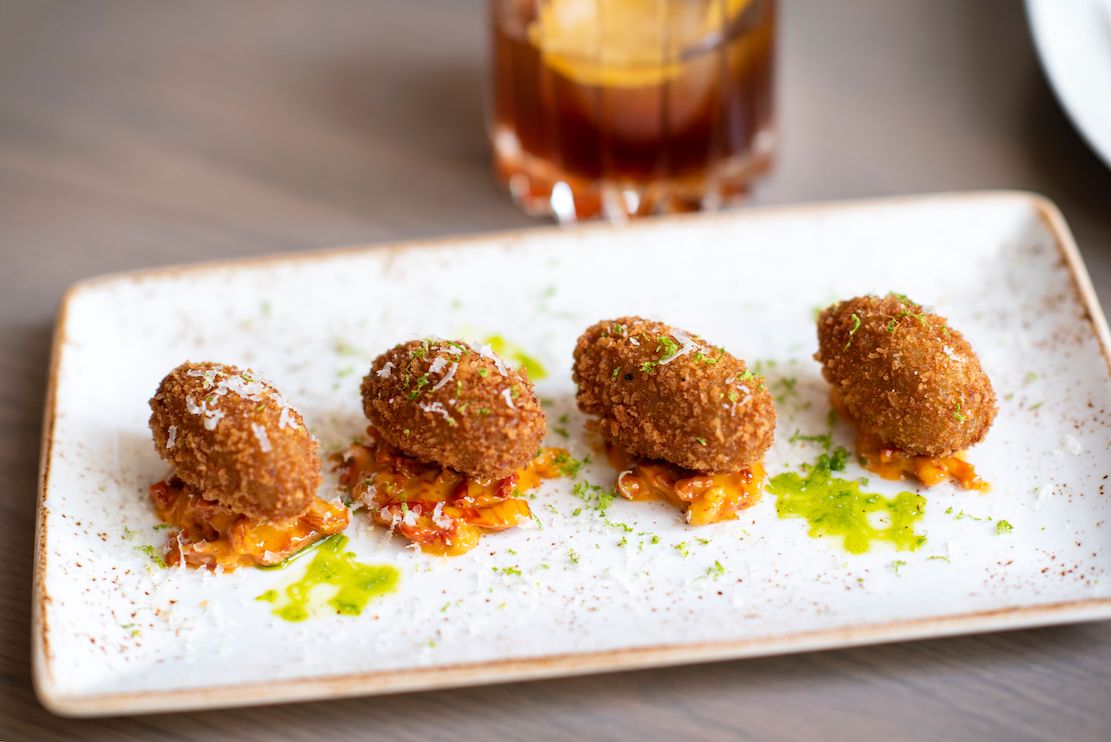 spiced
mango and pineapple relish with Caribbean herb
emulsion and a squid ink vinaigrette ($17).
Grilled octopus is served with Peruvian potatoes
and a mojo
Gallego sauce ($21), while setas
(wild mushrooms) and gambas
(shrimp) come with a vibrant salsa azafran
in a garlic-rich saffron broth ($19). You
really cannot miss the unusual croquettes (left)
of sweet plantains with tangy sun-dried tomato
slaw, lime zest and grated manchego cheese to give
them a creamy dairy accent ($14). There is also a
prettily composed remolacha
salad of roasted beets, smoked goat’s cheese,
Caribbean pesto and popped wild race ($14), the
kind of dish that would be very rare to find in
the Caribbean.
spiced
mango and pineapple relish with Caribbean herb
emulsion and a squid ink vinaigrette ($17).
Grilled octopus is served with Peruvian potatoes
and a mojo
Gallego sauce ($21), while setas
(wild mushrooms) and gambas
(shrimp) come with a vibrant salsa azafran
in a garlic-rich saffron broth ($19). You
really cannot miss the unusual croquettes (left)
of sweet plantains with tangy sun-dried tomato
slaw, lime zest and grated manchego cheese to give
them a creamy dairy accent ($14). There is also a
prettily composed remolacha
salad of roasted beets, smoked goat’s cheese,
Caribbean pesto and popped wild race ($14), the
kind of dish that would be very rare to find in
the Caribbean.
The main plates may be shared, which adds
to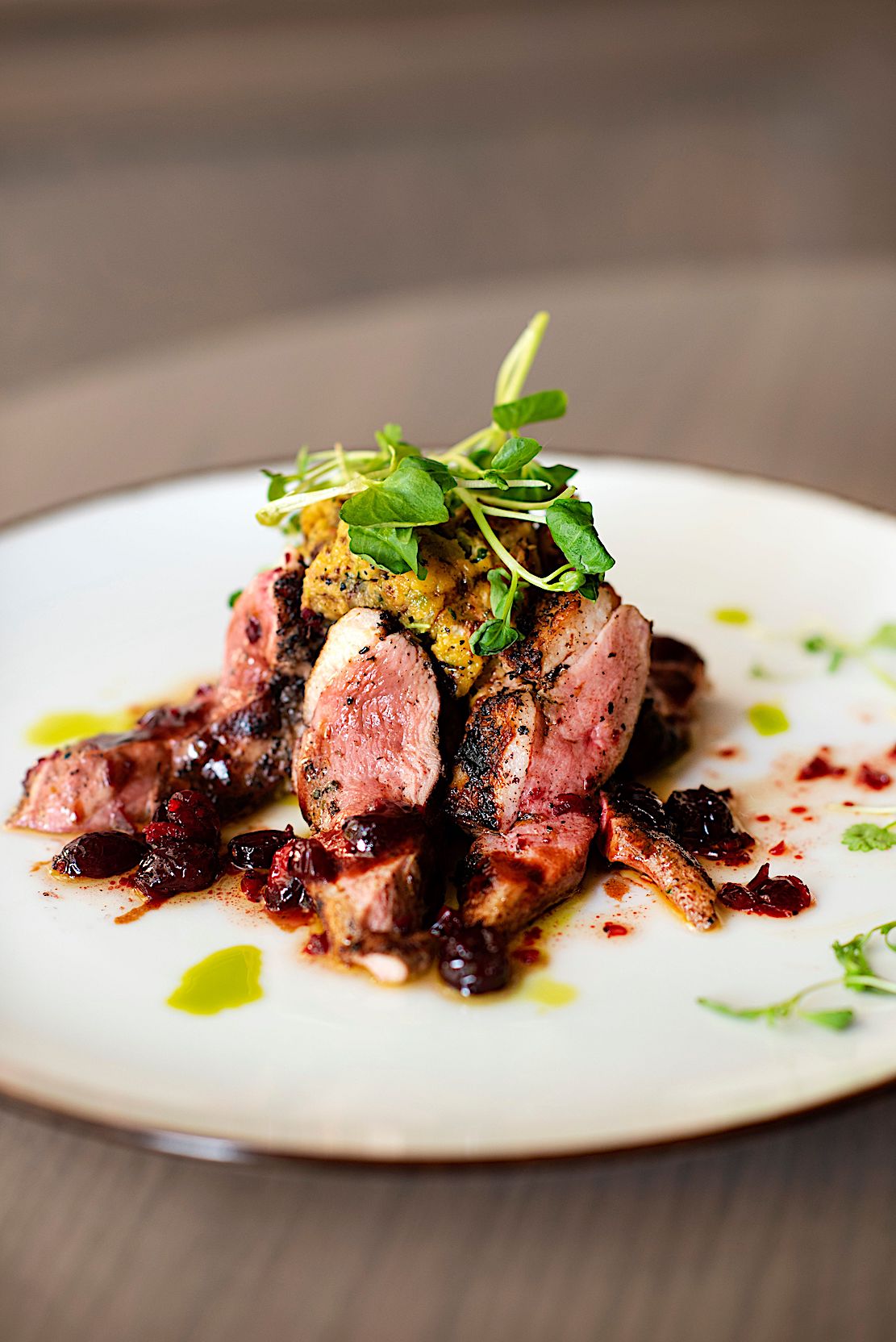 the fun of an evening at Tasca. Lomo de
cerdo is grilled pork tenderloin fillet,
very tender, with a deep, dark black bean purée
and a jalapeño salad ($29). Goat’s
cheese buoys many a dish on the menu to good
effect, as in the magret de
pato of spice-rubbed duck paired with sweet
plantain and Zinfandel-soaked goat cheese ($35).
The grilled skirt steak called churrasco
has plenty of deep beefy flavor and a nice
chewiness, sided by fat yucca fries, Caribbean mojo
sauce and hot chimichurri
($32).
the fun of an evening at Tasca. Lomo de
cerdo is grilled pork tenderloin fillet,
very tender, with a deep, dark black bean purée
and a jalapeño salad ($29). Goat’s
cheese buoys many a dish on the menu to good
effect, as in the magret de
pato of spice-rubbed duck paired with sweet
plantain and Zinfandel-soaked goat cheese ($35).
The grilled skirt steak called churrasco
has plenty of deep beefy flavor and a nice
chewiness, sided by fat yucca fries, Caribbean mojo
sauce and hot chimichurri
($32).
There are two representative paellas
on the menu, a classic Spanish Valenciana
($62 for two) and fideua,
made with thin spaghetti rather than rice ($58 for
two), both of which are easy enough for a table to
dig into and search the bottom for the crispy bits
called socarrat. I must
admit I’m of two minds about paella.
On the one hand it’s a festive, savory, steaming
dish brought to the table in its shallow pan; on
the other hand, it’s not so different from so many
other countries’ rice and seafood renderings, and,
having eaten it several times in Valencia, I’ve
always found it somewhat bland. Tasca’s is
somewhat better seasoned, but it’s not a stand-out
among so many dishes that are.
Generous desserts stay on the traditional
side, like the coconut tres leches
cake, suffused with sweet condensed caramel, and pudin de pan
banana bread pudding with a luscious rum raisin
glaze.
The Espinals have cellared a terrific wine
list, largely from Latin countries, with plenty of
very good labels under $60. Wines by the glass run
$12-$18, and there’s not a clunker among the
selections. They also offer specialty cocktails,
of which the City of Gold made with tequila,
orange, honey and chili pepper seasoning ($16) is
a winner. There is also an admirable list of more
than 100 rums.
On the Upper West Side there
are plenty of good but unadventurous eateries, so
it’s good to see the Espinals going a long Latin
mile to be unique among the rest. For this Tasca
is not just one of the best new places in that
neck of the woods but one of the most enticing of
its kind anywhere in the city right now.
Tasca is open for
dinner nightly and for brunch Sat. & Sun.
CAPONE’S
GOLD
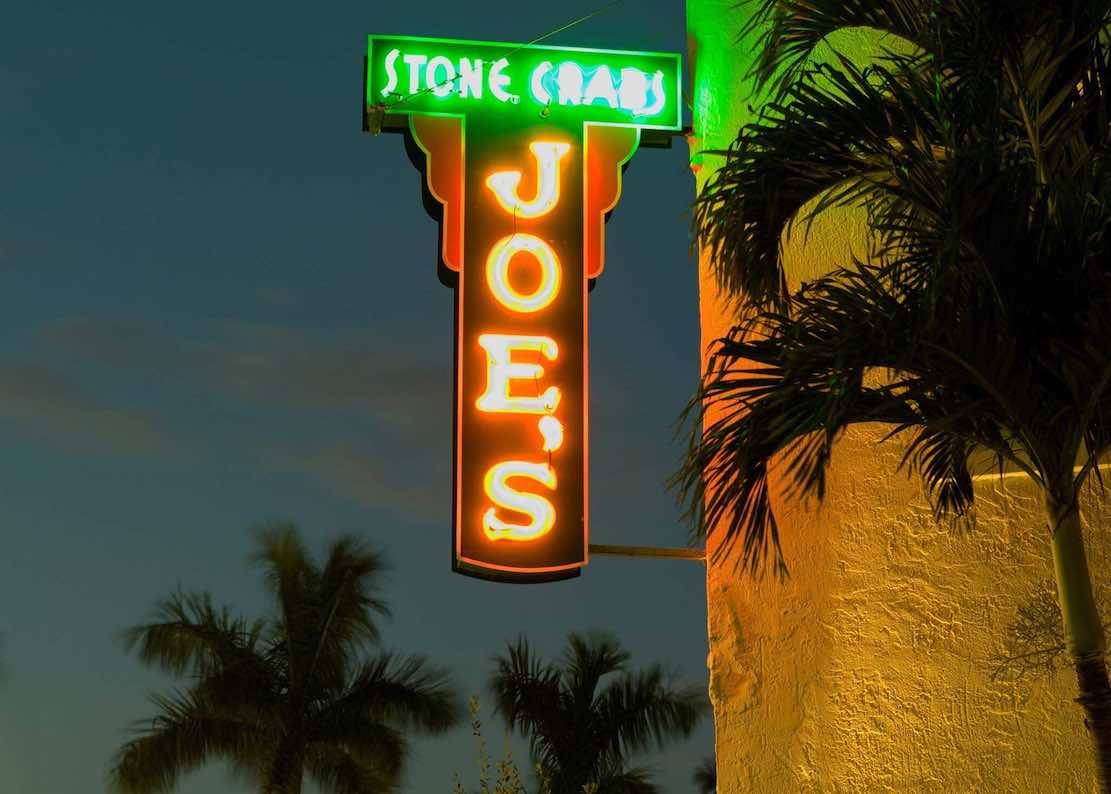
They
drove to the hotel on Washington Avenue,
picked up their bags and headed to the
restaurant on the southern tip of Miami Beach. At
dinnertime the place was always packed and
tipping the maître d’ was considered standard
procedure just to get a table at all. The
bigger the tip the shorter your wait.
“I hate that bullshit,” said David, who
loathed all forms of bribery. “It’s highway
robbery. That’s why I go for lunch, when it’s
not crowded and you can get right in.”
They got a pleasant table in the
cavernous restaurant and ordered platters of
jumbo stone crab claws with butter sauce and
mustard-flavored mayo. They skipped 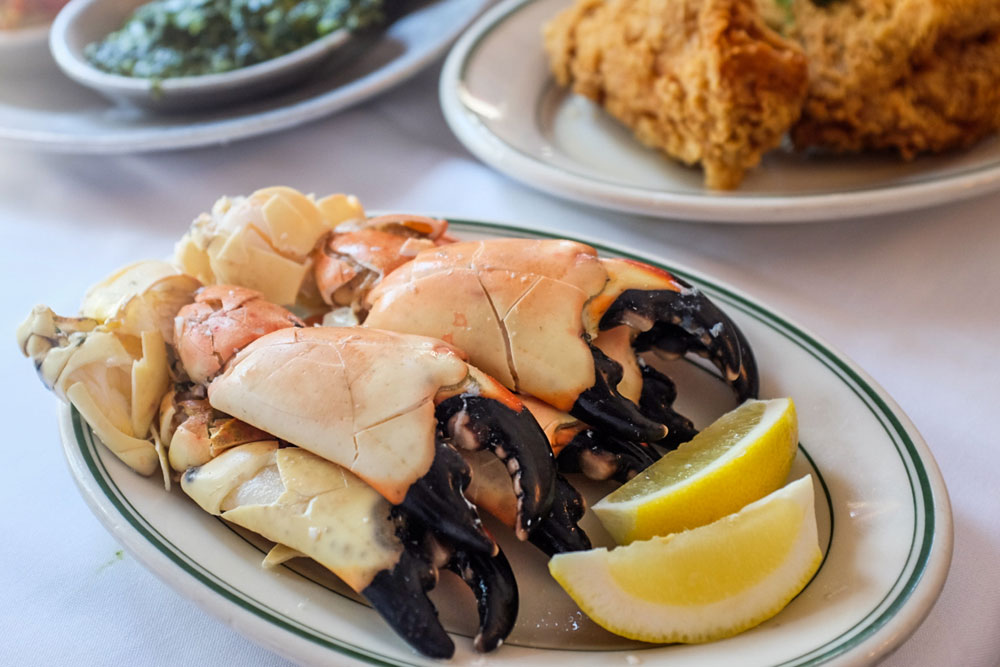 having
wine
but David had a beer.
having
wine
but David had a beer.
“Good thing we’re on expense account,”
said David, picking the meat out of one cracked
claw. “These crabs cost a fortune.”
“Oh, but they really are so sweet,” said
Katie. “I happen to know this is one of my
editor’s favorite restaurants, so we’re good.”
“So let’s assess where we are,” said
David. “You first.”
“Well, I’m intrigued that Al had two fast
speedboats docked at his house. They could have
sailed the gold over to Bimini or Cuba.”
“I thought so, too,” said David, “except
that bullion is so damn heavy, those would have
to be very big boats with deep drafts to
displace the sea water. If they were lugging the
gold to the islands, it would take way too many
trips, and the more trips, the more scrutiny by
the feds, who must have kept an eye on Capone
when he got out of prison and settled here.”
 “So you think that
none of the gold is in Florida?” asked Katie.
“So you think that
none of the gold is in Florida?” asked Katie.
“I just don’t know at this point. It had
to go somewhere and Capone had his tentacles in
this part of the world. But it bothers the hell
out of me why he didn’t act on his plan when he
got out. Why didn’t he call the feds, tell them
he knew where the gold was without admitting
anything and have the feds send him a big fat
Treasury check?”
“I know. That bothers me, too,” she said.
“Especially because by then he had very little
money left, from what I’ve read. The legal fees
and paybacks to the government were enormous and
he had nothing coming in all those year while he
sat in jail. He already owned the mansion, but
there seems no evidence he left his wife and
relatives with, excuse the expression, a pot of
gold when he died.”
“I know. Nothing’s making a whole lot of
sense. It’s always possible his cronies, or
enemies, got hold of the gold, divided it up,
whatever. But
they too would have trouble doing anything with
it because, like you told me, Americans couldn’t
own, sell or trade gold until, what, 1975?”
“Well,” said Katie, “we may find out
something about the will, if there was one, if
we get to see Theresa Scali, which I assume is
either her married name or one she took.”
“It’s
worth a nice three-hour drive along the coast.”
“Hey, did you get a mobile phone?”
“Not yet. I don’t know which brand to
buy.”
“Nokia. They have the best coverage.”
“An Italian phone company?”
“No, David,” laughed Katie, “It’s
Japanese, spelled N-O-K-I-A.”
“Ah. Can you pass the cole slaw?”
*
*
*
*
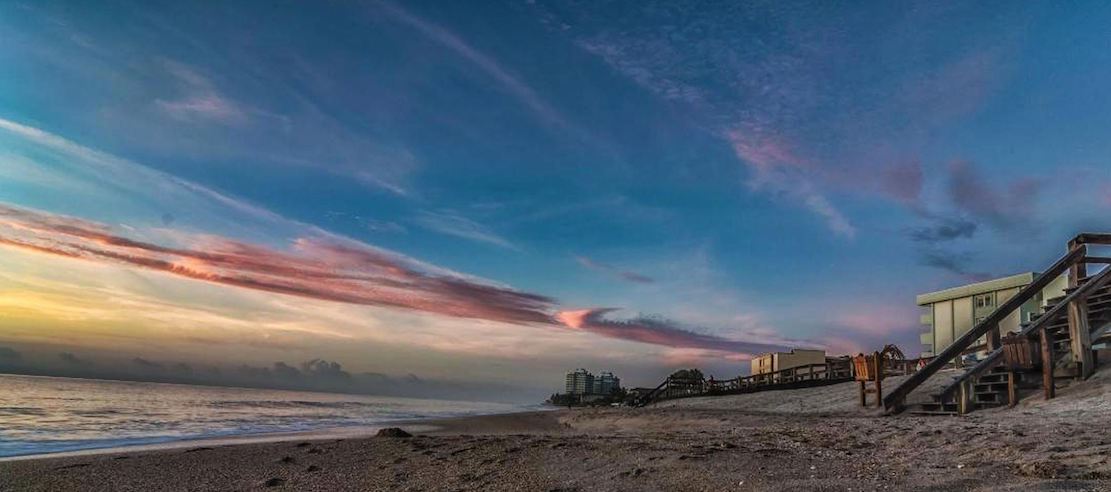
VERO BEACH
On
the drive up to Vero Beach Katie used her
mobile phone to call Theresa Scali. She
and David rehearsed what she should say to get
the woman to speak to them. Katie dialed the
number and after three rings a woman answered.
“Hello?”
“Hello, my name is Katie Cavuto and I’m
trying to reach Theresa Scali.”
“This is she.”
“Mrs. Scali, I don’t wish to intrude but
I’m a writer from New York and I’m doing an
article on Al Capone, who I believe was your
uncle.”
“He was.”
Katie
felt the chill in Mrs. Scali’s voice but
continued.
“Well, I was wondering if I might stop by
your house for just a few minutes and ask you
some questions related to your uncle?”
“Frankly, Miss Cavuto, my uncle is a
person I don’t really care to discuss.”
“I can understand why,” said Katie.
“No, you can’t. It’s not because I don’t
like being linked to my uncle, it’s because
people—especially people in the press—didn’t
know the man the way I did. No
one’s ever written about the way my uncle was
when he wasn’t doing business.”
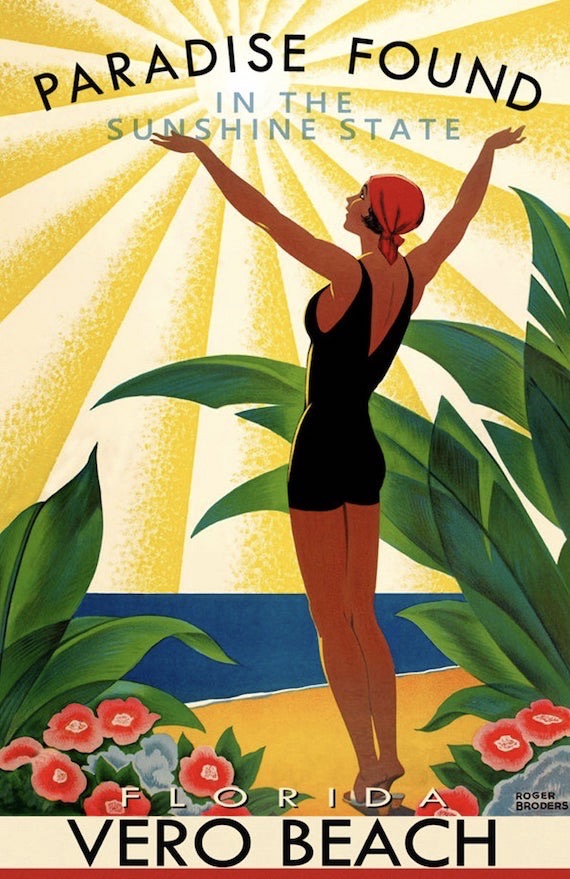 Katie
sensed a touch of denial in Mrs. Scali’s voice
but thought she might use it to her advantage.
Katie
sensed a touch of denial in Mrs. Scali’s voice
but thought she might use it to her advantage.
“Well, just telling me that,” said Katie,
“is why I’d like to speak with you. I agree with
you that everything you read—everything I read,
too—about your uncle is about what he did, not
what he was like. I want to write about the more
personal side of Al Capone. How he was with his
family.” (She
didn’t mention the gold heist.)
“You say that. How do
I know I can trust you?”
“Well, for one thing, anything I write
down that you say, I’ll let you read over. And I
won’t have a recorder with me. And,
if you want to, I’ll give you the name and
number of my editor at McClure’s
magazine to vouch for what I just said.”
“You write for McClure’s?” asked
Mrs. Scali. “I like that magazine. They seem to
do honest reporting. The writing’s good.”
Katie put her hand over the phone and
whispered to David, “I think we’re okay.”
“Tell you what,” said Mrs. Scali, “are
you in the area?”
“I'm driving to Vero Beach from Miami
right now.”
“Sounds like you’re pretty sure of
yourself already.”
“And it sounds like you’re a very smart
woman,” said Katie, thinking maybe that was
being a bit condescending.
“All right, if you can be here tomorrow
morning around ten o’clock, I’ll speak with you,
but I’m not making any promises about a long
interview.”
“I understand, and I’m very grateful.”
“You have my address?”
“I think so: 2333 Belvedere Drive?”
“Yes, it’s right off Route One.”
“Okay, then, I’ll see you at ten tomorrow
morning.”
Katie hung up and gave a big smile to
David, who wasn’t smiling.
“What?” asked Katie. “I got the
interview.”
“You told her ‘I’ll’ see you in the
morning; not ‘we’ll.’”
Katie replied, “Only because I hadn’t
mentioned you.”
“Well, you did the right thing. If she
found out you’re bringing an ex-cop with you,
she’d probably slam the door in your face.”
“That was in the back of my mind, too.”
“You’ll do fine,” he said. “We’ll go over
some questions tonight.”
© John Mariani, 2015
❖❖❖
THE LAST ROSÉS OF SUMMER
By
John Mariani
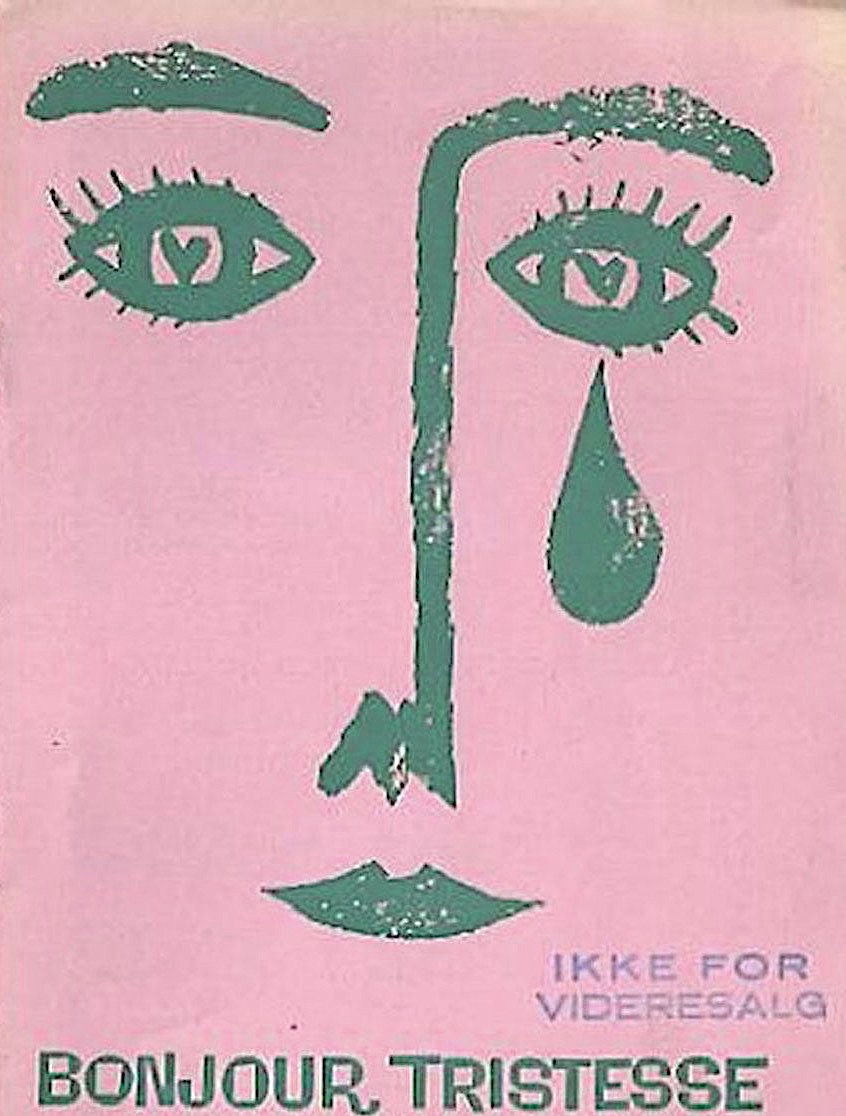 Every wine writer, including this one,
dutifully writes a rosé wine article at the
beginning of summer and always reminds readers
that they can be enjoyed any time of year. Now,
having drunk so many rosés this summer, I’ve
found many delicious and many rather bland.
Inherent to many very pale rosés is that they
don’t have the extraction from red grape skins
to give them much body, and I do tend to find
the bigger bodied examples more satisfying,
unless they are too sweet.
Every wine writer, including this one,
dutifully writes a rosé wine article at the
beginning of summer and always reminds readers
that they can be enjoyed any time of year. Now,
having drunk so many rosés this summer, I’ve
found many delicious and many rather bland.
Inherent to many very pale rosés is that they
don’t have the extraction from red grape skins
to give them much body, and I do tend to find
the bigger bodied examples more satisfying,
unless they are too sweet.
That said, I’m getting more discerning
about rosés, so, now that it’s July, let me
recommend some that go well beyond the ordinary
and have their own distinctiveness. And, yes,
you can drink them all year round.
Let’s begin with some sparklers.
Mumm Grand Cru Rosé ($52)—A nicely priced
rosé Champagne that shows how a blend of
Chardonnay, Meunier and Pinot Noir grapes can
combine in a delicate balance, and making a rose
is always tricky in Champagne. This has good fruit
and nice backbone of light sweetness rather than
bone dry banality.
Mumm Napa Brut Rosé ($24)—Mumm’s California
winery draws from 50 of the region’s vineyards for
the best Pinot Noirs, whose lots are fermented
separately, most in stainless steel, others in
oak. The blend is 80% Pinot Noir, 20% Chardonnay,
with alcohol at 12.5%. It’s got a brightness and
lovely fruit and you should pop the cork all
summer with this one. 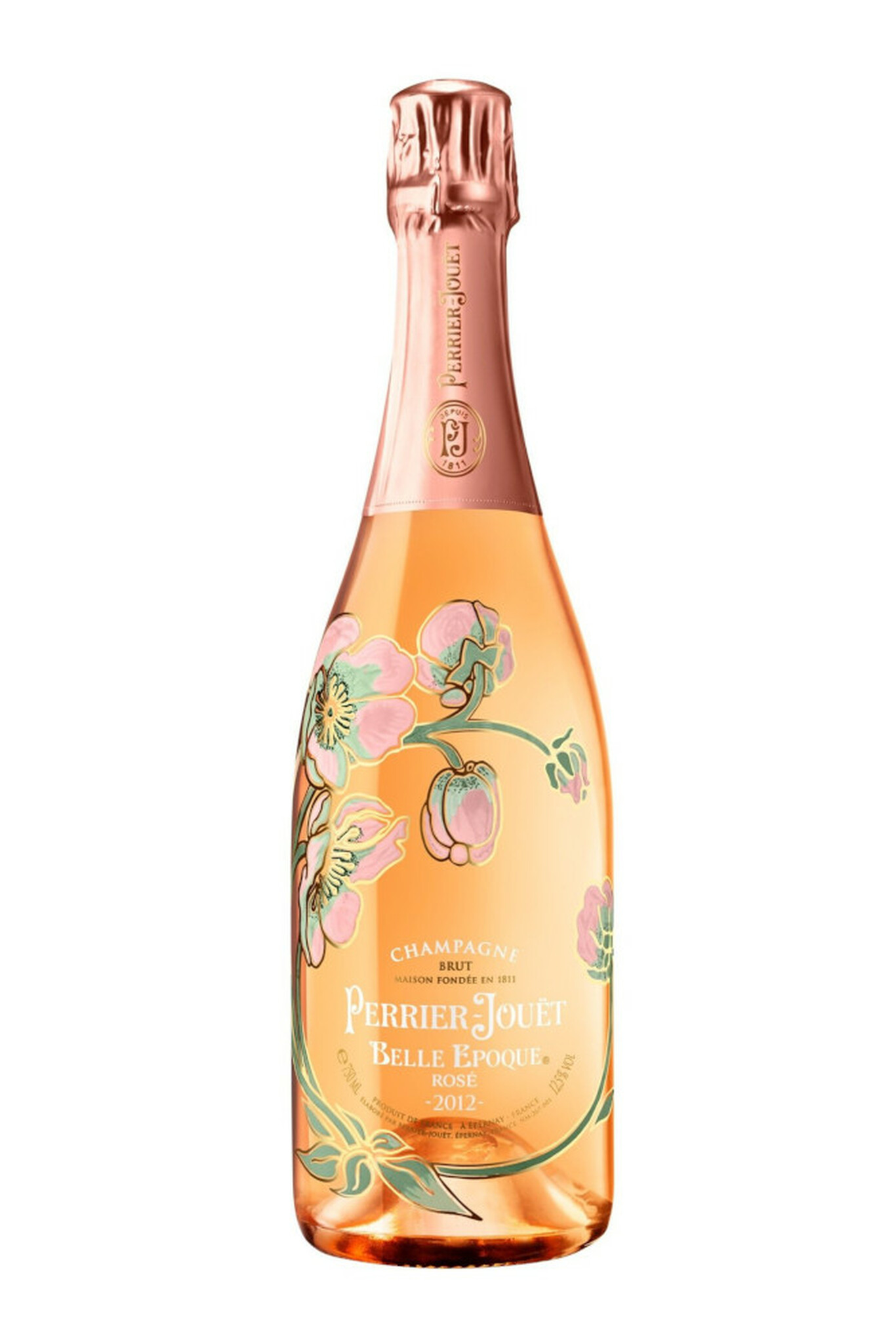
Perrier-Jouët Blason
Rosé
($80)—Perrie-Jouët is known for the flower motif
on its bottles, and indeed, if you like floral
notes, this is the go-to Champagne, especially
this rose (actually a lovely salmon color) made
from 25% Chardonnay,
50% Pinot Noir and 25% Meunier. It is easily
matched with appetizers and all fish, short of
those in a very spicy sauce.
Perrier-Jouet Belle
Époque
($305) —Yes, the price is a stunner, though most
of the prestige cuvées hover in this stratosphere.
You are paying for P-J’s top-of-the-line, or
perhaps better put, crème de la crème, made only
in the finest vintages. You get a great array of
woodsy flowers and nut flavors with spice, a
lasting mousse and unusually long-lasting finish
as rewarding as the first sip is refreshing.
Unless you are very, very rich, this is what you
should drink with your immediate family for a
celebration, not for every guest at your
daughter’s wedding.

Risata Sparkling Rosé ($15)—With 70%
Chardonnay and 30% Pinot Noir, this is a sparkling
wine from Italy’s Veneto, not made in the
Champagne method. The grapes are vinified
separately, then blended in pressurized tanks for
the second fermentation that begins the
effervescence. The result is a light wine, at just
11% alcohol, for easy quaffing as an aperitif any
time you’re in the mood.
Duca di Salaparuta
Calaníca Rosato 2020 ($16)—Salaparuta is one
of Sicily’s oldest wineries, and they produce
wines from three estates, This is a non-sparkling
rosato
made from native Grillo and
other grapes as an IGT wine with 11.5% alcohol. It
stays in stainless steel for only a month,
followed by another in the bottle, so the obvious
aim is freshness and fruit with moderate acidity
that makes this a fine match with shellfish. 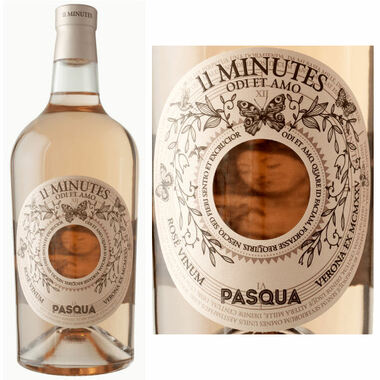
Pasqua 11 Minutes Rosé
Vinum 2020 ($20)—Made in the Veneto with native
varietals like Corvina
and Trebbiano di Lugana, as well as Syrah and
Carmenère, this rosato has good body at 12.5%
alcohol. The
name “11 Minutes” refers to the duration of the
skin contact and the soft pressing of grapes,
which then spends 11 hours in stainless steel to
separate the must, then transferred to other
tanks for fermentation, all the while remaining
on its lees. Trebbiano is not a powerhouse white
grape but it does add liveliness to the red
Syrah and hearty Carménère. The result has
complexity and elegance, very good with dishes
like spaghetti with clams or grilled chicken.
❖❖❖

OUR WACKY, SHEEPISH STARS
At chef and owner Pim Techamuanvivit’s Thai restaurant Nari in San Francisco, someone called asking for a last-minute reservation for “a table of Noma people,” apparently referring to Copenhagen's famous Noma restaurant. When the party arrived, it turned out to be Kanye West, who took over the semi-private room.
❖❖❖
Sponsored by

Any of John Mariani's books below may be ordered from amazon.com.
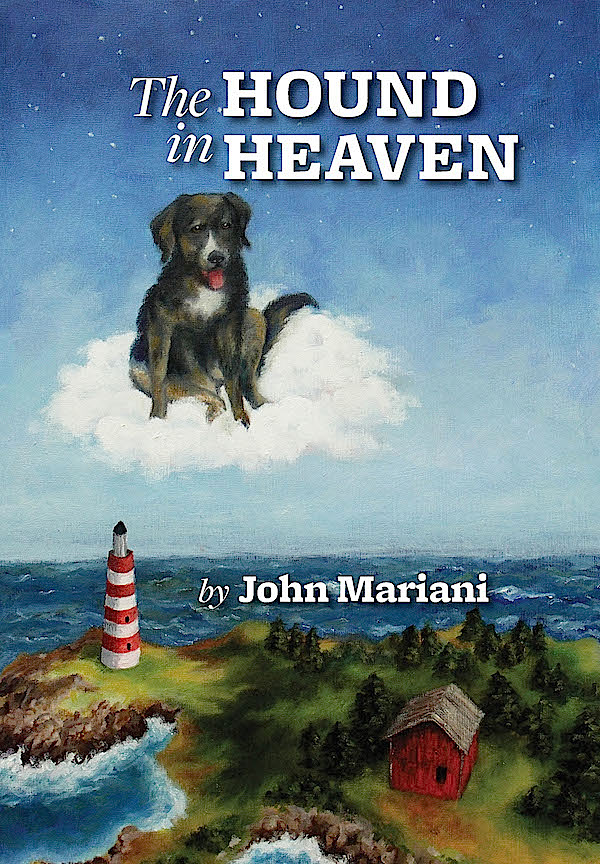 The Hound in Heaven (21st
Century Lion Books) is a novella, and for
anyone who loves dogs, Christmas, romance, inspiration,
even the supernatural, I hope you'll find this to be a
treasured favorite. The story concerns how,
after a New England teacher, his wife and their two
daughters adopt a stray puppy found in their barn in
northern Maine, their lives seem full of promise. But when
tragedy strikes, their wonderful dog Lazarus and the
spirit of Christmas are the only things that may bring his
master back from the edge of despair.
The Hound in Heaven (21st
Century Lion Books) is a novella, and for
anyone who loves dogs, Christmas, romance, inspiration,
even the supernatural, I hope you'll find this to be a
treasured favorite. The story concerns how,
after a New England teacher, his wife and their two
daughters adopt a stray puppy found in their barn in
northern Maine, their lives seem full of promise. But when
tragedy strikes, their wonderful dog Lazarus and the
spirit of Christmas are the only things that may bring his
master back from the edge of despair. WATCH THE VIDEO!
“What a huge surprise turn this story took! I was completely stunned! I truly enjoyed this book and its message.” – Actress Ali MacGraw
“He had me at Page One. The amount of heart, human insight, soul searching, and deft literary strength that John Mariani pours into this airtight novella is vertigo-inducing. Perhaps ‘wow’ would be the best comment.” – James Dalessandro, author of Bohemian Heart and 1906.
“John Mariani’s Hound in Heaven starts with a well-painted portrayal of an American family, along with the requisite dog. A surprise event flips the action of the novel and captures us for a voyage leading to a hopeful and heart-warming message. A page turning, one sitting read, it’s the perfect antidote for the winter and promotion of holiday celebration.” – Ann Pearlman, author of The Christmas Cookie Club and A Gift for my Sister.
“John Mariani’s concise, achingly beautiful novella pulls a literary rabbit out of a hat – a mash-up of the cosmic and the intimate, the tragic and the heart-warming – a Christmas tale for all ages, and all faiths. Read it to your children, read it to yourself… but read it. Early and often. Highly recommended.” – Jay Bonansinga, New York Times bestselling author of Pinkerton’s War, The Sinking of The Eastland, and The Walking Dead: The Road To Woodbury.
“Amazing things happen when you open your heart to an animal. The Hound in Heaven delivers a powerful story of healing that is forged in the spiritual relationship between a man and his best friend. The book brings a message of hope that can enrich our images of family, love, and loss.” – Dr. Barbara Royal, author of The Royal Treatment.
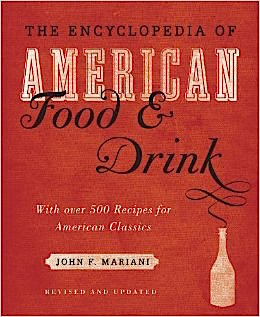 |
The Encyclopedia of American Food and Drink by John F. Mariani (Bloomsbury USA, $35) Modesty forbids me to praise my own new book, but let me proudly say that it is an extensive revision of the 4th edition that appeared more than a decade ago, before locavores, molecular cuisine, modernist cuisine, the Food Network and so much more, now included. Word origins have been completely updated, as have per capita consumption and production stats. Most important, for the first time since publication in the 1980s, the book includes more than 100 biographies of Americans who have changed the way we cook, eat and drink -- from Fannie Farmer and Julia Child to Robert Mondavi and Thomas Keller. "This book is amazing! It has entries for everything from `abalone' to `zwieback,' plus more than 500 recipes for classic American dishes and drinks."--Devra First, The Boston Globe. "Much needed in any kitchen library."--Bon Appetit. |
"Eating Italian will never be the same after reading John Mariani's entertaining and savory gastronomical history of the cuisine of Italy and how it won over appetites worldwide. . . . This book is such a tasteful narrative that it will literally make you hungry for Italian food and arouse your appetite for gastronomical history."--Don Oldenburg, USA Today. "Italian
restaurants--some good, some glitzy--far
outnumber their French rivals. Many of
these establishments are zestfully described
in How Italian Food Conquered the World, an
entertaining and fact-filled chronicle by
food-and-wine correspondent John F.
Mariani."--Aram Bakshian Jr., Wall Street
Journal.
"Equal parts
history, sociology, gastronomy, and just
plain fun, How Italian Food Conquered the
World tells the captivating and delicious
story of the (let's face it) everybody's
favorite cuisine with clarity, verve and
more than one surprise."--Colman Andrews,
editorial director of The Daily
Meal.com. "A fantastic and fascinating
read, covering everything from the influence
of Venice's spice trade to the impact of
Italian immigrants in America and the
evolution of alta cucina. This book will
serve as a terrific resource to anyone
interested in the real story of Italian
food."--Mary Ann Esposito, host of PBS-TV's
Ciao
Italia. "John Mariani has written the
definitive history of how Italians won their
way into our hearts, minds, and
stomachs. It's a story of pleasure over
pomp and taste over technique."--Danny Meyer,
owner of NYC restaurants Union Square
Cafe, The Modern, and Maialino.
|
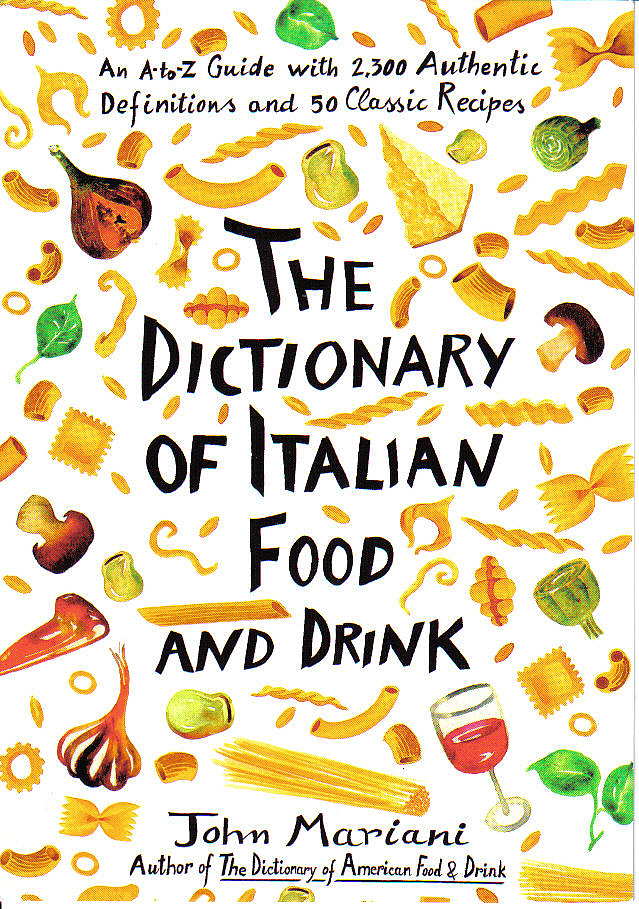 |
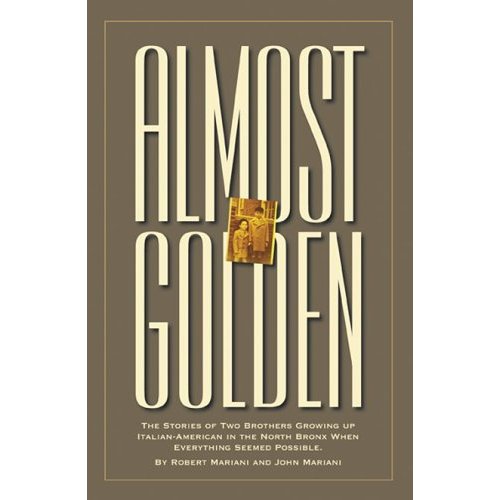 |
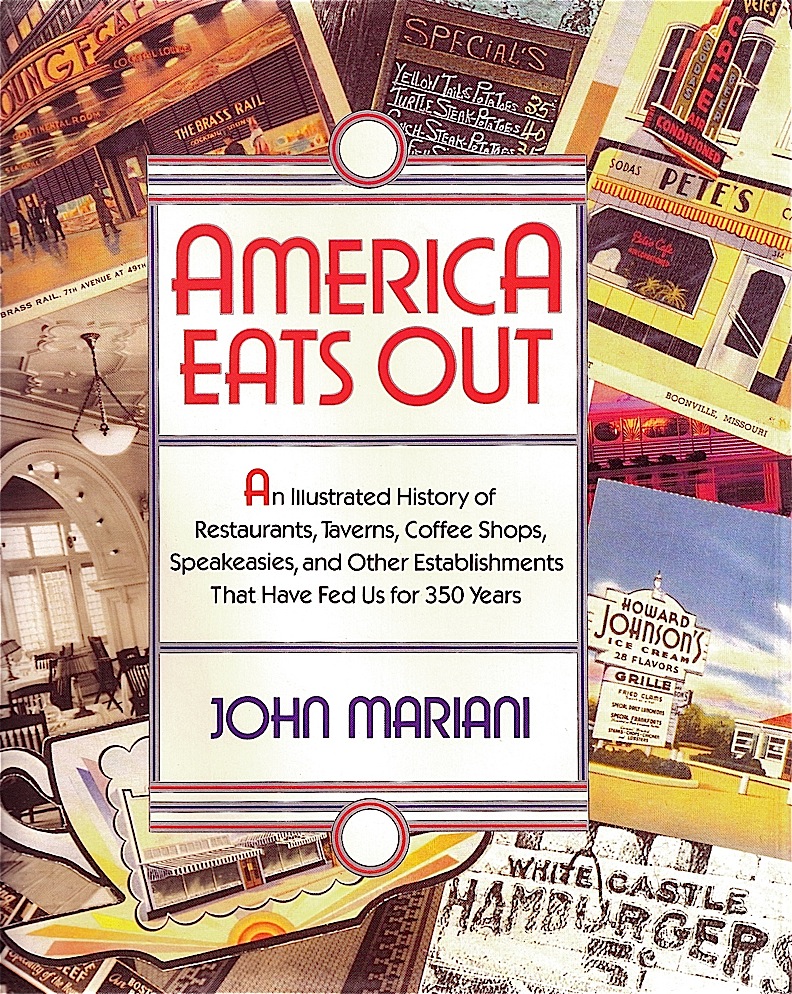 |
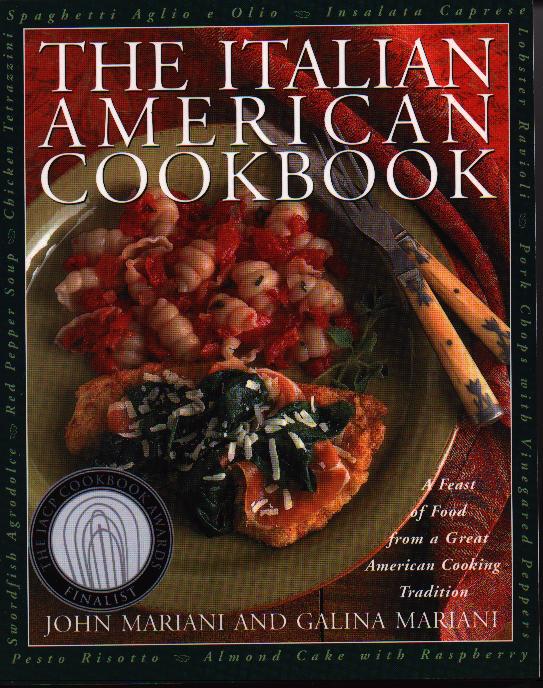 |
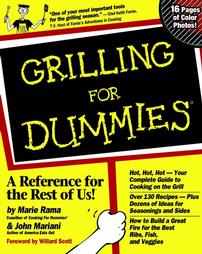 |
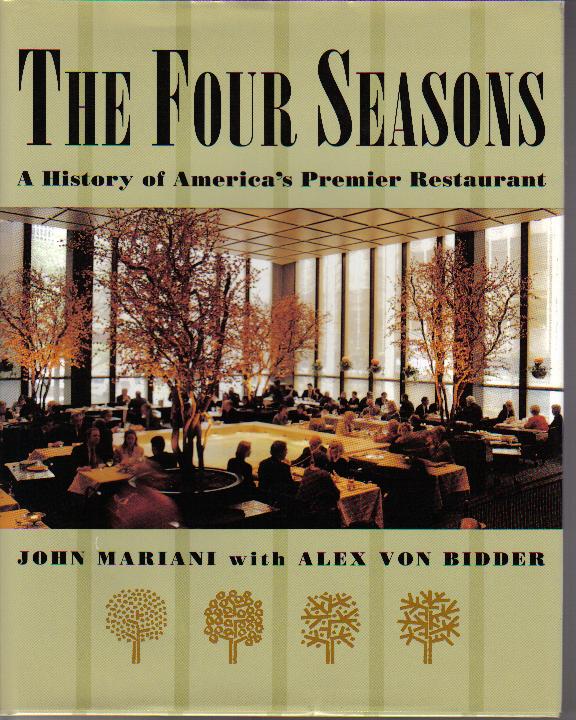 |
 Everett Potter's Travel Report:
Everett Potter's Travel Report: 
 Eating Las
Vegas JOHN CURTAS has been covering
the Las Vegas food and restaurant scene
since 1995. He is the co-author of EATING LAS
VEGAS – The 50 Essential Restaurants (as
well as the author of the Eating Las
Vegas web site: www.eatinglasvegas.
He can also be seen every Friday morning as
the “resident foodie” for Wake Up With the
Wagners on KSNV TV (NBC) Channel 3 in
Las Vegas.
Eating Las
Vegas JOHN CURTAS has been covering
the Las Vegas food and restaurant scene
since 1995. He is the co-author of EATING LAS
VEGAS – The 50 Essential Restaurants (as
well as the author of the Eating Las
Vegas web site: www.eatinglasvegas.
He can also be seen every Friday morning as
the “resident foodie” for Wake Up With the
Wagners on KSNV TV (NBC) Channel 3 in
Las Vegas.
MARIANI'S VIRTUAL GOURMET
NEWSLETTER is published weekly. Publisher: John Mariani. Editor: Walter Bagley. Contributing Writers: Christopher Mariani,
Robert Mariani, Misha Mariani, John A. Curtas, Gerry Dawes, Geoff Kalish,
and Brian Freedman. Contributing
Photographer: Galina Dargery. Technical
Advisor: Gerry
McLoughlin.
If you wish to subscribe to this
newsletter, please click here: http://www.johnmariani.com/subscribe/index.html
© copyright John Mariani 2021
